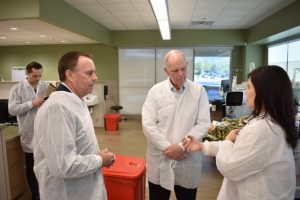Many people in the world live in regions with selenium-poor soil and, consequently, with selenium-poor food. The body cannot synthesize selenium, which is an essential non-metal trace element that we need in small amounts. A recent review of selenium status and the risk of cardiovascular disease suggests that serum selenium status below 100 mcg/L is associated with increased risk of heart disease, with reduced exercise capacity, with reduced quality of life, and with worse prognosis [Al-Murbarak].
- Low intakes of selenium mean low selenium status.
- Sufficient selenium is required for the formation of the amino acid selenocysteine, which is, in turn, an essential component of selenoproteins.
- Low selenium status over longer periods of time can put individuals at greater risk of cardiovascular disease, cancer, and autoimmune thyroid disorders.
- Adequate selenium intake and status are necessary for good immune function and protection against infectious diseases.

- Particularly vulnerable to have low selenium status are individuals who are vegetarians and vegans, pregnant and breastfeeding women, overweight or obese individuals, HIV-patients, kidney-dialysis patients, and individuals on parenteral nutrition as well as individuals living in selenium-poor regions.
Where is selenium status likely to be low?
Stoffaneller and Morse conducted a comprehensive study – 143 references – of selenium status in Europe, the UK, and the Middle East. They concluded that selenium intake and status are generally suboptimal in European and Middle Eastern countries, with somewhat more variation in the Middle East. They reported that suboptimal selenium status is widespread throughout Europe and the UK, with Eastern European countries having lower selenium intakes than Western European countries. In the Middle Eastern countries, they found varying results, which were possibly caused by different food habits and different imports in different regions and within differing socioeconomic groups [Stoffaneller & Morse].
In much of Africa and Asia (especially some regions of China, Siberia, Tibet, and Korea), there is low selenium content in soil and food. Likewise, New Zealand and parts of Australia and parts of South America have selenium-poor regions [Haug].
In the USA, regions in the West, especially the Northwest, and in the Northeast and in the Southeast down to Florida tend to have lower distributions of selenium in the soil than in the rest of the country [Ralston].
By contrast, regions of the world with unusually high soil selenium concentrations are regions in Wyoming and North and South
Dakota in the USA, in Enshi County in China, and in parts of Ireland, Colombia, and Venezuela [Haug].

Note. Selenium is available in the world in limited quantities, and much selenium is required for industrial purposes. Consequently, large-scale fertilization of the soil with selenium, as was done in Finland, is not economically feasible in the selenium-poor regions of the world [Alfthan; Haug]. Selenium supplementation is the less wasteful and more sustainable option.
Why is sufficient selenium status important?
Higher selenium status is associated with enhanced immune function, with better outcomes for viral infections including HIV virus progression to AIDS. Higher selenium status is also associated with less risk of some forms of cancer, with improved male fertility and pregnancy rates, and with lowered risk of cardiovascular disease [Mangiapane].
Selenium is involved in numerous biological functions, primarily as part of the amino acid, selenocysteine, which is found in at least 25 selenium containing proteins (selenoproteins). Selenocysteine is the fundamental building block into which selenium is incorporated; selenocysteine is essential for the catalytic activity of many enzymes [Mangipane].
Some selenoproteins are better characterized than others. Among the well-known selenoproteins are the glutathione peroxidases, the thioredoxin reductases, the iodothyronine deiodinases, the selenoprotein P.
Individuals who have low selenium status or selenium deficiency may have poor physiological responses to stress, including oxidative stress.
Note: Oxidative stress has been defined as a imbalance between the production of reactive oxygen species (free radicals) and antioxidant defenses [Betteridge].
For example, Keshan cardiomyopathy and Kashin-Beck osteoarthropathy are diseases occurring specifically in selenium-poor regions in Asia and linked specifically to low selenium intakes [Delage].
How much selenium intake is enough?
The most common selenium protein, glutathione peroxidase-1, is dependent upon adequate selenium supply. Normal glutathione peroxidase activity requires a serum selenium value of at least 90-100 mcg/L [Duffield]. Selenium’s important transport protein, Selenoprotein P, the most prevalent selenoprotein in the blood, requires plasma selenium levels of at least 125 mcg/L [Hurst 2010].
A meta-analysis of 12 studies enrolling 13,254 participants (5007 cases of prostate cancer) has shown an association between plasma/serum selenium levels and the incidence of prostate cancer in which the risk of prostate decreased with increasing plasma/serum selenium from 60 mcg/L up to 170 mcg/L [Hurst 2012].
The serum/plasma selenoprotein P concentration is, accordingly, a more appropriate bio-marker than serum/plasma glutathione peroxidase concentration [Hurst 2012].
A review of prospective studies has shown that the relationship between blood selenium concentrations and the risk of poor health outcomes and mortality can be described by a U-shaped curve. Adequate selenium status – the range in which the risk of poor health and mortality is lowest – seems to be in the range of 130 – 150 mcg/L of serum selenium [Rayman].
What form of selenium supplement gives antioxidant protection?
Richie et al. conducted a randomized double blind, placebo-controlled trial of selenium-enriched yeast preparations (containing 200 or 285 mcg/day) and selenomethionine (200 mcg/day) administered for 9 months to 69 healthy men. The compliance was high in all groups (>95%).
The participants’ plasma selenium levels increased 93%, 54%, and 86% after nine months in selenomethionine and low-dose and high-dose selenium-enriched yeast groups, respectively. Plasma selenium concentrations returned to baseline levels after a three-month washout period.
The research data showed significant reductions in bio-markers of oxidative stress following supplementation with the selenium-enriched yeast preparations but not with the selenomethionine preparation. The findings suggest that selenium species other than selenomethionine account for the decrease in oxidative stress [Richie].
Sources
Al-Mubarak AA, van der Meer P, Bomer N. Selenium, Selenoproteins, and Heart Failure: Current Knowledge and Future Perspective. Curr Heart Fail Rep. 2021 Jun;18(3):122-131.
Alfthan G, Eurola M, Ekholm P, Venäläinen E-R, Root T, Korkalainen K. Effects of nationwide addition of selenium to fertilizers on foods, and animal and human health in Finland: From deficiency to optimal selenium status of the population. J Trace Elem Med Biol. 2015;31:142–7.
Betteridge DJ. What is oxidative stress? Metabolism. 2000 Feb;49(2 Suppl 1):3-8.
Delage B. Selenium. Oregon State University. Linus Pauling Institute. Micronutrient Information Center. 2014. Retrieved from https://lpi.oregonstate.edu/mic/minerals/selenium.
Duffield AJ, Thomson CD, Hill KE, Williams S. An estimation of selenium requirements for New Zealanders. Am. J. Clin. Nutr. 1999;70:896–903.
Haug A, Graham RD, Christophersen OA & Lyons GH. How to use the world’s scarce selenium resources efficiently to increase the selenium concentration in food. Microb Ecol Health Dis. 2007;19(4):209–228.
Hurst R, Armah CN, Dainty JR, Hart DJ, Teucher B, Goldson AJ, Broadley MR, Motley AK, Fairweather-Tait SJ. Establishing optimal selenium status: results of a randomized, double-blind, placebo-controlled trial. Am J Clin Nutr. 2010 Apr;91(4):923-31.
Hurst R, Hooper L, Norat T, Lau R, Aune D, Greenwood DC, Vieira R, Collings R, Harvey LJ, Sterne JA, Beynon R, Savović J, Fairweather-Tait SJ. Selenium and prostate cancer: systematic review and meta-analysis. Am J Clin Nutr. 2012 Jul;96(1):111-22.
Mangiapane E, Pessione A, Pessione E. Selenium and selenoproteins: an overview on different biological systems. Curr Protein Pept Sci. 2014;15(6):598-607.
National Institutes of Health. Office of Dietary Supplements. Selenium Fact Sheet for Health Professionals. 2021. Retrieved from https://ods.od.nih.gov/factsheets/Selenium-HealthProfessional/.
Ralston N. Selenium’s pivotal roles in relation to mercury exposure risks. EERC Conference: Promoting Healthy Communities. September 26, 2011.
Rayman MP. Selenium and human health. Lancet. 2012 Mar 31;379(9822):1256-68.
Richie JP Jr, Das A, Calcagnotto AM, Sinha R, Neidig W, Liao J, Lengerich EJ, Berg A, Hartman TJ, Ciccarella A, Baker A, Kaag MG, Goodin S, DiPaola RS, El-Bayoumy K. Comparative effects of two different forms of selenium on oxidative stress biomarkers in healthy men: a randomized clinical trial. Cancer Prev Res (Phila). 2014 Aug;7(8):796-804.
The information presented in this review article is not intended as medical advice and should not be used as such.
15 August 2021

